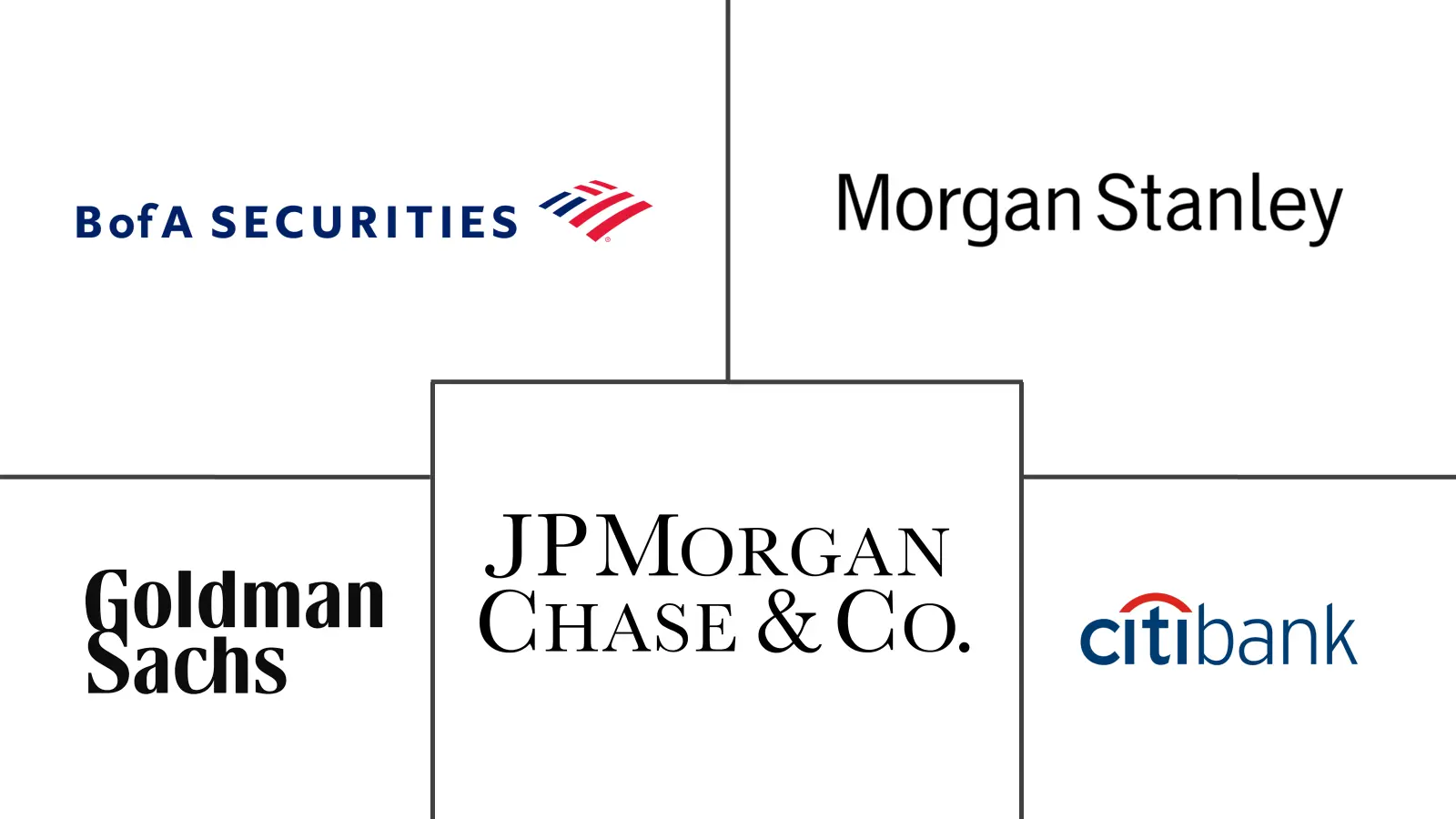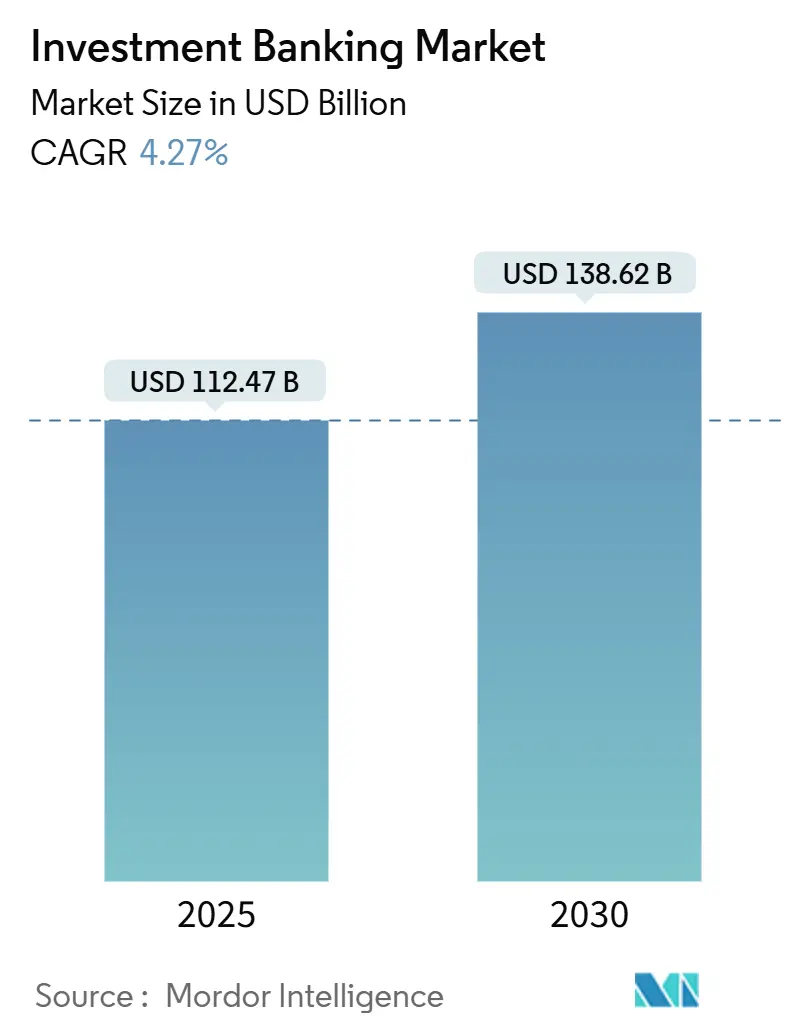
Investment Banking Market Analysis by Mordor Intelligence
The Investment Banking Market size is estimated at USD 112.47 billion in 2025, and is expected to reach USD 138.62 billion by 2030, at a CAGR of 4.27% during the forecast period (2025-2030).
Rate-cut cycles in the United States, stabilizing inflation, and healthy corporate balance sheets are creating favorable conditions for mergers, acquisitions, and capital-market issuances. Deal pipelines are replenishing as private-equity sponsors reopen exit routes and corporates prioritize strategic expansion over share buy-backs. At the same time, artificial-intelligence deployments are lowering operating costs, while tokenization pilots are expanding product scope for both public and private-market assets. Regulatory recalibration—especially the gradual roll-out of Basel III revisions—continues to shape capital allocation decisions, pressuring return profiles yet encouraging new fee opportunities in advisory, risk transfer, and capital optimization services.
Key Report Takeaways
- By product type, mergers and acquisitions held 38.97% of the investment banking market share in 2024, whereas equity-capital markets are forecasted to advance at a 5.61% CAGR to 2030.
- By deal size, transactions in the USD 1–5 billion range commanded 34.25% share of the investment banking market size in 2024; sub-USD 250 million deals are projected to expand fastest at a 6.76% CAGR through 2030.
- By client type, large enterprises accounted for 74.66% share of the investment banking market in 2024, while small- and medium-sized enterprises (SMEs) are projected to grow at a 7.23% CAGR to 2030.
- By industry vertical, banking, financial services, and insurance led with a 20.78% share of the investment banking market in 2024; healthcare and pharmaceuticals are expected to post the swiftest 5.96% CAGR between 2025 and 2030.
- By geography, North America dominated with a 52.56% share of the investment banking market in 2024, and Asia-Pacific is poised to record the highest 6.47% CAGR through 2030.
Global Investment Banking Market Trends and Insights
Drivers Impact Analysis
| Driver | ( ~ ) % Impact on CAGR Forecast | Geographic Relevance | Impact Timeline |
|---|---|---|---|
| Sustained acceleration in global M&A volumes | +1.2% | North America and Europe lead | Medium term (2-4 years) |
| Robust expansion of debt-capital markets | +0.8% | United States and Europe | Short term (≤ 2 years) |
| Resurgence of IPO and SPAC activity | +0.6% | North America and Asia-Pacific | Medium term (2-4 years) |
| Rapid increase in ESG-linked underwriting | +0.4% | Europe leads; global adoption | Long term (≥ 4 years) |
| Emergence of tokenized securities | +0.3% | Asia-Pacific and North America | Long term (≥ 4 years) |
| Growing sovereign-wealth-fund deployments | +0.5% | MENA and Asia-Pacific | Medium term (2-4 years) |
| Source: Mordor Intelligence | |||
Sustained acceleration in global M&A volumes
Global deal value is rebounding as financing costs ease and boardroom confidence improves. Major banks forecast 10%–15% growth in aggregate M&A value for 2025, led by cross-border combinations in technology, healthcare, and industrials. Private-equity sponsors are re-entering the market to resolve exit backlogs, altering the competitive bid landscape, and lifting advisory pipelines. Industrial manufacturers illustrate the trend, pursuing scale to digitize production, replace aging assets, and meet sustainability targets. Healthcare activity mirrors this momentum, with large pharmaceutical companies tackling looming patent cliffs through bolt-on acquisitions and licensing transactions.
Robust expansion of debt-capital markets
Lower real yields and upcoming refinancing walls are driving record bond issuance windows. Corporates plan to float more than USD 1.5 trillion of U.S. paper in 2025, switching from short-dated to longer-tenor structures as the Federal Reserve eases policy. In Europe, declining policy rates underpin an 8% increase in investment-grade supply expectations for 2025. Investor appetite for high-yield remains solid, helped by coupons above 7.5% in the U.S. and 5.7% in Europe. Sustainable bonds are adding further volume, with projections that green, social, and sustainability-linked formats will approach EUR 900 billion in 2025[1]Baker McKenzie, “Global Leveraged Finance Review 2024,” bakermckenzie.com .
Resurgence of IPO and SPAC activity
Improved equity-market sentiment narrowed valuation gaps between public and private assets, allowing 163 U.S. IPOs in 2024 that raised USD 23.7 billion. Technology and biotechnology listings headline the queue, buoyed by strong demand for artificial-intelligence and life-sciences exposure. The return of a leading U.S. bank to SPAC sponsorship underscores growing comfort with regulatory clarity and better deal structures. Strong GDP prints above 2% for 2025-2026 further support risk appetite, prompting venture and private-equity investors to accelerate exit timetables.
Rapid increase in ESG-linked underwriting and advisory mandates
Institutional investors continue embedding climate-transition objectives into mandates, prompting global banks to scale sustainability originations. Several universal banks have set green-financing targets between USD 500 billion and USD 1 trillion over multi-year horizons. Dedicated clean-energy teams and transition funds are emerging to address an estimated USD 7 trillion annual financing need for achieving net-zero goals. Enhanced disclosure frameworks are bolstering comparability across issuers, unlocking fee pools in structuring, verification, and impact-measurement services.
Restraints Impact Analysis
| Restraint | ( ~ ) % Impact on CAGR Forecast | Geographic Relevance | Impact Timeline |
|---|---|---|---|
| Heightened post-crisis regulatory capital demands | -0.7% | Global; staggered roll-outs | Short term (≤ 2 years) |
| Intensifying fee compression and price rivalry | -0.5% | Global; commoditized segments | Medium term (2-4 years) |
| Accelerated talent migration toward fintech roles | -0.3% | North America and Europe | Medium term (2-4 years) |
| Escalating cyber-security and resilience costs | -0.2% | Global; financial services a prime target | Long term (≥ 4 years) |
| Source: Mordor Intelligence | |||
Heightened post-crisis regulatory capital, liquidity, and resolution requirements
Basel III end-game rules ratified in the United States lift minimum capital 9%–16% for large banks, while Europe’s CRR III imposes output floors that raise Tier 1 requirements 8.6%–12.2%. Divergent timelines across the U.K., EU, and U.S. complicate group-wide capital planning and can skew product profitability. Banks are increasingly issuing capital-relief transactions and synthetic risk-transfer structures to navigate higher risk-weighted asset charges. The resulting balance-sheet constraints may curtail risk-warehousing capacity in trading and underwriting desks[2]Katten, “U.S. Banking Agencies Issue Final Basel III Endgame Rules,” katten.com.
Intensifying fee compression and price competition
Global advisory and underwriting fees declined significantly in 2023, reaching their lowest level in several years, as banks competed aggressively for a smaller transaction pool. Clients are insisting on milestone-based pricing and demanding digital-data transparency, eroding historical premium margins. Institutions have responded with cost-takeout programs, automation initiatives, and staff redeployments; one major U.K. bank’s efficiency review with an external consultant targets hundreds of millions in annual savings. Rising deposit costs and flatter loan-to-deposit spreads further squeeze profitability, underscoring the urgency of scale economies[3]The Banker, “Investment Banking Fees Hit Five-Year Low,” thebanker.com.
Segment Analysis
By Product Type: M&A Retains Leadership While ECM Accelerates
Mergers and acquisitions generated the largest 38.97% slice of the investment banking market in 2024, reflecting corporates’ preference for inorganic growth in a low-rate setting. Pent-up sponsor exits, cross-border consolidation, and strategic repositioning needs continue to populate pipelines, lifting fee pools for legal, valuation, and financing workstreams. On the debt side, historically attractive coupons support a steady issuance calendar, but regulatory capital charges on underwriting inventories remain a profitability drag.
Equity capital markets constitute the fastest-expanding segment, advancing at a 5.61% CAGR through 2030 on the back of revived IPO and follow-on activity. The investment banking market size for equity offerings is set to widen as AI, biotech, and clean-energy issuers tap public funds to accelerate innovation cycles. Recent easing of SPAC headwinds further diversifies listing routes, enabling issuers to pair capital raising with acquisition currency flexibility.
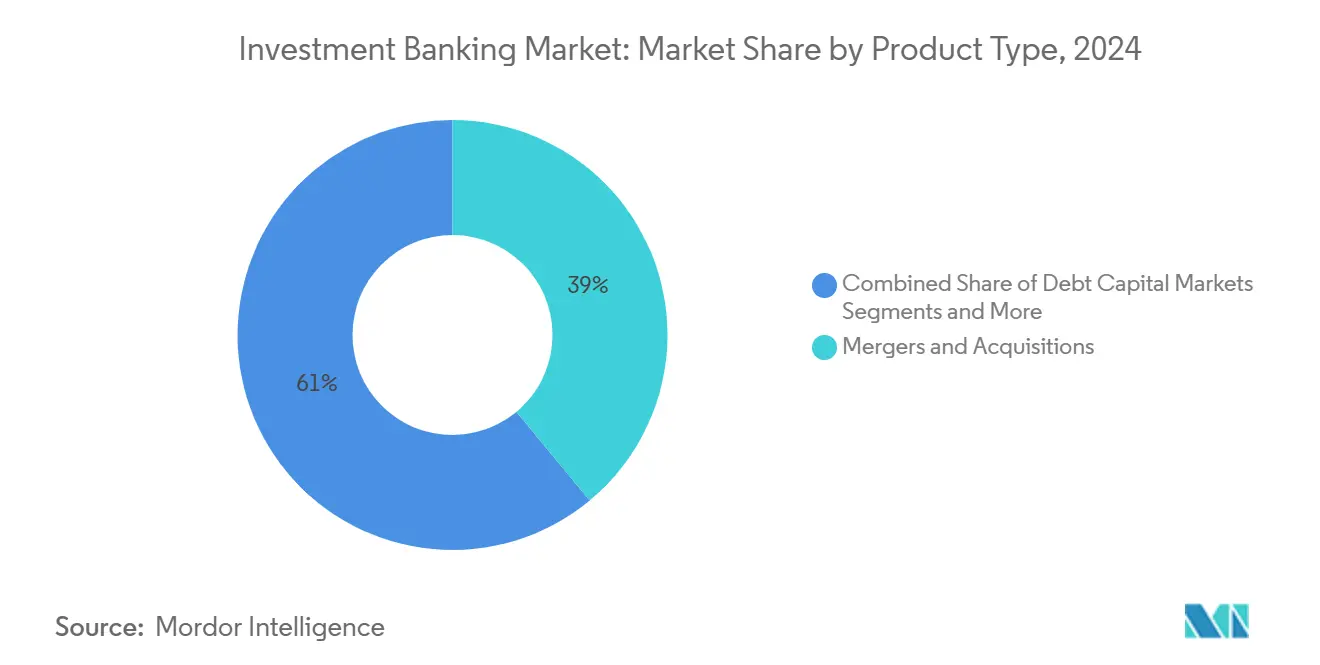
Note: Segment shares of all individual segments available upon report purchase
By Deal Size: Mid-to-Large Caps Dominate; Small-Caps Race Ahead
Transactions valued at USD 1–5 billion accounted for 34.25% of the investment banking market size in 2024, underscoring the appeal of strategically significant yet financially digestible deals that deliver scale efficiencies. Mega-deals above USD 5 billion remain episodic but draw marquee advisory fees when sector consolidation imperatives align with accommodating credit conditions.
Activity below USD 250 million is forecasted to register a brisk 6.76% CAGR as digital platforms simplify documentation and due diligence processes. Lower entry thresholds attract entrepreneurial founders and mid-cap corporates seeking bolt-on capabilities, particularly in advanced manufacturing and data-infrastructure niches. Automation in pitch generation and document management shortens execution timelines, making smaller tickets more economical for banking teams.
By Client Type: Enterprise Stronghold Faces SME Upswing
Large enterprises commanded 74.66% of the investment banking market size in 2024, leveraging multi-jurisdictional footprints that require complex structuring, liability management, and risk-management solutions. Board-mandated diversification strategies sustain a healthy demand for cross-border advisory and multi-currency capital-raising mandates, reinforcing the segment’s profitability.
SMEs are poised for a 7.23% CAGR through 2030, benefitting from digital-banking channels and regulatory frameworks tailored to lighter disclosure burdens. Embedded-finance applications, open-banking infrastructure, and AI-driven credit analytics are compressing onboarding costs, enabling banks to service smaller mandates profitably. Regional development banks and export-credit agencies are also stepping up guarantees, encouraging commercial banks to deepen SME exposure.
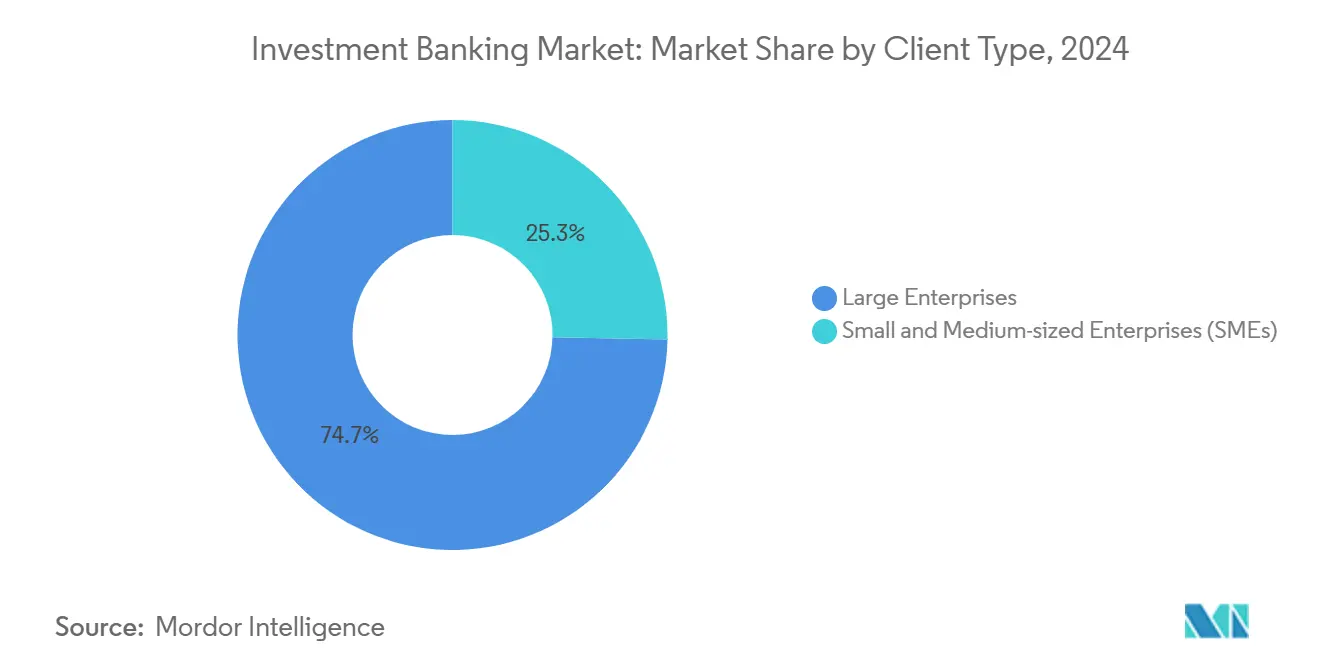
Note: Segment shares of all individual segments available upon report purchase
By Industry Vertical: BFSI Leads; Healthcare in High Gear
Banking, financial services, and insurance captured 20.78% of the investment banking market size in 2024, propelled by sector consolidation and technology transformation agendas that necessitate frequent capital optimization. Larger regional players are pursuing scale synergistically to offset rising compliance and tech budgets, which in turn fuels advisory demand.
Healthcare and pharmaceuticals, projected to expand at a 5.96% CAGR, exemplify defensive growth themes amid demographic tailwinds and relentless R&D pipelines. Patent-expiration schedules push big pharma toward biotech acquisitions that replenish drug pipelines and leverage specialized research capabilities. Simultaneously, life-science tools and digital-health platforms are riding strong valuation support, broadening the advisory canvas for bankers.
Geography Analysis
North America held a commanding 52.56% share of the investment banking market in 2024 as the region benefited from deep capital-market liquidity, accommodative monetary policy shifts, and anticipated regulatory easing. U.S. corporations intend to refinance more than USD 1 trillion of debt in 2025 and exploit a resurgent IPO window that already hosted 163 offerings in 2024. Canadian and Mexican issuers add complementary deal flow in mining, energy transition, and cross-border supply-chain reconfiguration.
Asia-Pacific is the fastest-growing region in the investment banking market, slated for a 6.47% CAGR through 2030. Structural reforms in China, India, and Southeast Asia are deepening local capital markets and encouraging outbound M&A. As transaction banking represents nearly half of regional CIB income, banks are scaling digital trade-finance platforms to win wallet share with SMEs and mid-caps. Japan and South Korea contribute through technology joint ventures and shareholder-return enhancements, while Australia’s infrastructure privatization pipeline supplies sizeable underwriting mandates.
Europe maintains relevance in the investment banking market despite macro uncertainty. Energy transition programs and sovereign-wealth-fund inflows from the Middle East are supporting infrastructure and renewables financing, while regulatory fragmentation complicates cross-border banking operations. In the Middle East, GCC banks are leveraging non-oil diversification projects and sovereign-wealth-fund deal-making, with regional investment-banking revenue expected to grow significantly in the coming years. Africa and South America provide niche opportunities in commodities, infrastructure, and fintech, attracting specialized advisory boutiques alongside global universal banks.
Competitive Landscape
The investment banking market remains moderately concentrated. JPMorgan Chase retained the top fee position recently, being the only major U.S. player to grow its share in a challenging year. Goldman Sachs, Morgan Stanley, Bank of America, and Citigroup round out the first tier, each focusing on technology differentiation and selective risk-appetite expansion.
Artificial-intelligence adoption is central to competitive strategy in the investment banking market. Goldman’s GS AI serves 10,000 employees across front-office functions, while JPMorgan’s IndexGPT applies large-language models to themed index construction. Vendors such as FactSet are reshaping workflow economics with generative-AI pitch-creation tools that cut slide-production time by 90%, freeing junior bankers for higher-value tasks.
Product specialization and geographic adjacency remain key battlegrounds. European franchises emphasize ESG advisory depth, Asian institutions leverage local syndication networks, and U.S. banks exploit balance-sheet strength to bundle lending with advisory services. As fee compression lingers, scale and technology investments become decisive in defending margins, prompting cost-efficiency programs and selective portfolio shedding.
Investment Banking Industry Leaders
-
J.P. Morgan Chase & Co.
-
Goldman Sachs Group Inc
-
Morgan Stanley
-
BofA Securities Inc.
-
Citi Group Inc
- *Disclaimer: Major Players sorted in no particular order
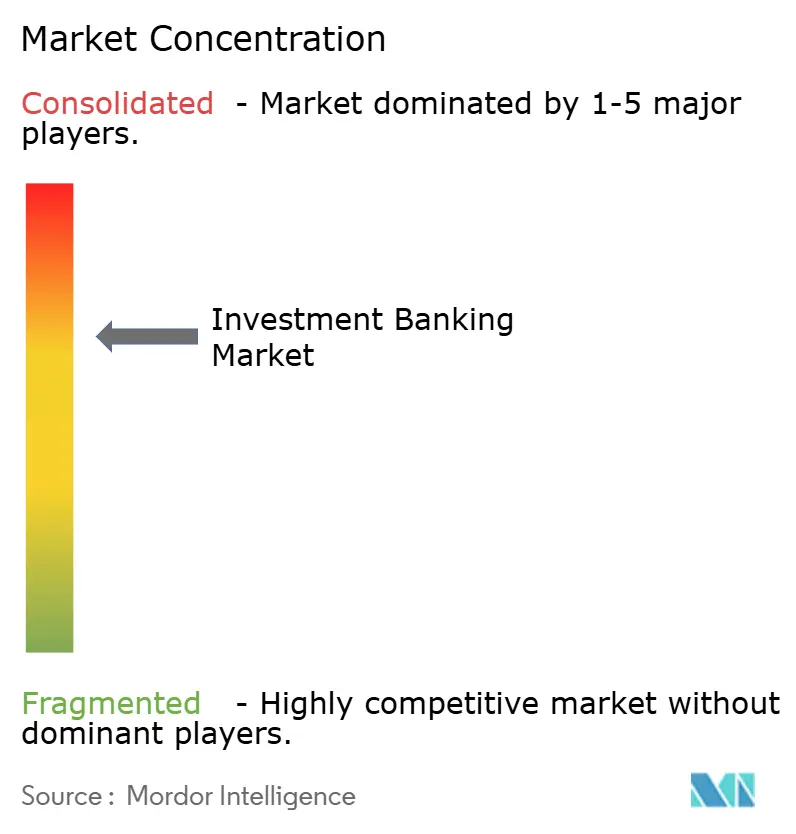
Recent Industry Developments
- June 2025: Cantor Fitzgerald bought UBS’s O’Connor alternatives platform, adding USD 11 billion in assets to boost its alternatives franchise.
- June 2025: Goldman Sachs lifted its three-year moratorium on SPAC deals, resuming blank-check underwriting under stricter sponsor criteria.
- May 2025: Citi and SDX partnered to tokenize private-market assets on SDX’s digital CSD, launching in Q3 2025.
- February 2025: Morgan Stanley rolled out an OpenAI-powered note-taking assistant for wealth-management meetings.
Research Methodology Framework and Report Scope
Market Definitions and Key Coverage
Mordor Intelligence defines the investment banking market as the revenue earned from advisory and capital-raising services, namely mergers and acquisitions, equity capital markets, debt capital markets, and syndicated lending, delivered by registered investment banks to corporate, institutional, and sovereign clients worldwide. Figures exclude proprietary trading, asset management, retail brokerage, and private-banking income.
Scope Exclusion: Trading desks' buy-side execution revenue and clearing fees lie outside this study.
Segmentation Overview
- By Product Type
- Mergers & Acquisitions
- Debt Capital Markets
- Equity Capital Markets
- Syndicated Loans & Others
- By Deal Size
- Mega-cap ( More than USD 5 billion)
- Large-cap (USD 1-5 billion)
- Mid-market (USD 250 million -1 billion)
- Small-cap (Less than USD 250 million)
- By Client Type
- Large Enterprises
- Small and Medium-sized Enterprises (SMEs)
- By Industry Vertical
- Banking, Financial Services, Insurance (BFSI)
- IT & Telecommunication
- Manufacturing
- Retail And E-Commerce
- Public Sector
- Healthcare And Pharmaceuticals
- Other Industry Verticals
- By Region
- North America
- United States
- Canada
- Mexico
- South America
- Brazil
- Argentina
- Chile
- Peru
- Rest of South America
- Europe
- United Kingdom
- Germany
- France
- Spain
- Italy
- Benelux (Belgium, Netherlands, and Luxembourg)
- Nordics (Sweden, Norway, Denmark, Finland, and Iceland)
- Rest of Europe
- Asia-Pacific
- China
- India
- Japan
- South Korea
- Australia
- South-East Asia (Singapore, Indonesia, Malaysia, Thailand, Vietnam, and Philippines)
- Rest of Asia-Pacific
- Middle East and Africa
- United Arab Emirates
- Saudi Arabia
- South Africa
- Nigeria
- Rest of Middle East and Africa
- North America
Detailed Research Methodology and Data Validation
Primary Research
We interview senior dealmakers, syndicate desk leads, and CFOs across North America, Europe, Asia-Pacific, and the Gulf to probe pipeline strength, fee spreads, and post-Basel capital allocation. Structured questionnaires and follow-up calls let us verify secondary findings, fill data gaps, and stress-test early model outputs.
Desk Research
Our analysts start with publicly available tier-one sources such as the US Securities and Exchange Commission filings, Financial Conduct Authority disclosures, Dealogic and Refinitiv league-table datasets, Organisation for Economic Co-operation and Development bond issuance statistics, and the International Monetary Fund's Financial Soundness Indicators. Macroeconomic context is strengthened through central-bank rate releases and Bank for International Settlements debt-service ratios. Company presentations, reputable financial press, and academic journals on Basel III capital buffers round out foundational inputs. Select paid platforms, including D&B Hoovers for bank financials and Dow Jones Factiva for deal news, supply timely validation. This list is illustrative; many additional sources inform our desk work.
Market-Sizing & Forecasting
A top-down reconstruction of historical fee pools uses disclosed global issuance volumes multiplied by sampled average fee percentages for M&A, ECM, DCM, and loans. We then reconcile totals with selective bottom-up checks, such as rolling up the ten largest banks' advisory revenues, to fine-tune anomalies. Key variables driving the model include announced-to-completed deal ratios, cross-border M&A share, high-yield issuance spreads, private-equity dry-powder levels, and Basel III "Endgame" risk-weighted asset inflation. Forecasts run through a multivariate regression that links these drivers to fee growth before scenario analysis adjusts for macro shocks. Where disclosure gaps appear, weighted regional proxies are applied and later overwritten once firmer data emerge.
Data Validation & Update Cycle
Outputs undergo multi-stage variance checks, analyst peer reviews, and outlier flagging against SIFMA fee trackers. Our team revisits sources quarterly; full models refresh annually or sooner if material events, such as rate shocks or policy shifts, move the market.
Why Mordor's Investment Banking Baseline Earns Trust
Published estimates often diverge because firms adopt dissimilar scopes, currencies, and refresh cadences. Mordor's disciplined segmentation, driver-based forecasting, and yearly updates anchor a figure that decision-makers can rely on.
Benchmark comparison
| Market Size | Anonymized source | Primary gap driver |
|---|---|---|
| USD 112.47 B (2025) | Mordor Intelligence | - |
| USD 424.07 B (2025) | Global Consultancy A | Includes trading services and brokerage flows, uses revenue recognition rather than fee generation, relies on top-down only |
| USD 150.49 B (2025) | Trade Journal B | Excludes syndicated lending, applies single global growth rate, refreshes every four years |
Other publishers swing higher when they merge trading income or lower when they strip out loan-related fees. By isolating pure advisory and capital-raising revenues and validating each input with market fingerprints, Mordor delivers a balanced, transparent baseline that is repeatable for clients and auditors alike.
Key Questions Answered in the Report
What is the current size of the investment banking market?
The investment banking market stands at USD 112.47 billion in 2025 and is projected to reach USD 138.62 billion by 2030.
Which region is growing fastest in investment banking?
Asia-Pacific is the fastest-growing region, expected to register a 6.47% CAGR through 2030 due to capital-market liberalization and rising deal flow.
What product segment leads the market?
Mergers and acquisitions dominate with 38.97% share of the investment banking market size in 2024, benefitting from renewed corporate appetite for transformative deals.
How are regulatory changes affecting investment banks?
Basel III end-game rules are lifting capital requirements 9%–16% for large U.S. banks, prompting capital relief trades and selective balance-sheet scaling.
Why are AI tools important for investment banks now?
Generative-AI assistants reduce manual tasks, improve pitch speed, and may lift profits by enhancing cost efficiency and client responsiveness.
Which client segment offers the highest growth potential?
Small- and medium-sized enterprises are projected to expand at a 7.23% CAGR, driven by digital platforms that lower advisory and capital-raising barriers.
Page last updated on:
